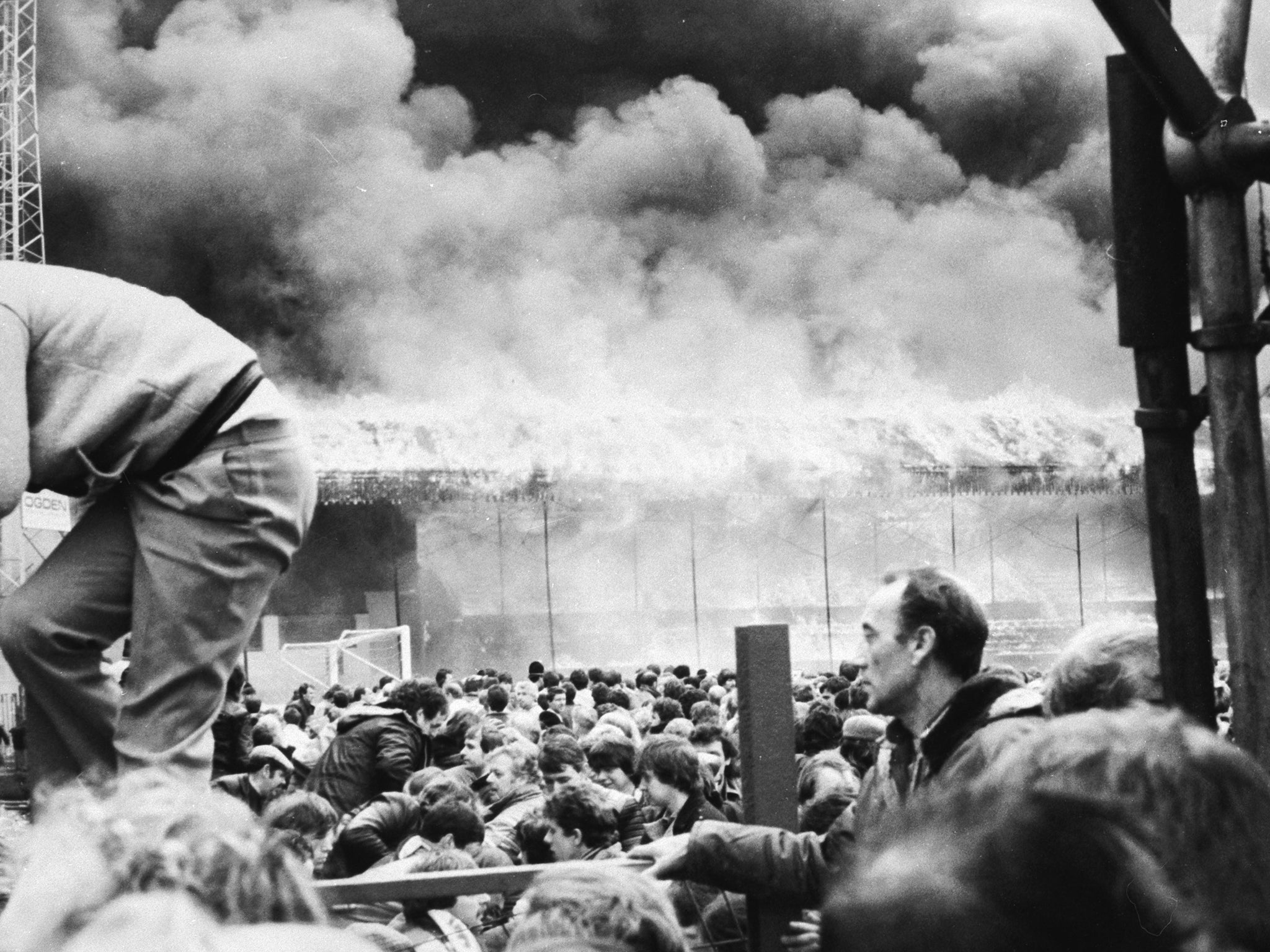Bradford City stadium fire: New evidence casts more doubt on verdict Bradford fire was accident
EXCLUSIVE: National Archive papers reveal testing – rushed and scant as it was – undermines theory lit match caused stadium disaster

A detailed scientific investigation into the causes of the Bradford stadium disaster cast statistical doubt on the claim that it was sparked inadvertently by a match igniting debris below Valley Parade’s seating, The Independent can reveal.
The fire, in which killed 56 supporters died, 30 years ago next month, was found by the official inquiry conducted by High Court judge Sir Oliver Popplewell to have been caused by debris beneath the seats in the main stand being accidentally set alight. But an investigation for Popplewell into the likely causes, published by the Department of the Environment’s Fire Research Station (FRS) 30 days after the tragedy and part of the body of evidence relating to the disaster at the National Archive in Kew, tested the likelihood of a match struck by a spectator still being alight when it fell to the floor. The experiments, which recreated the conditions at Valley Parade, found that 35 out of 48 matches tested “self-extinguished” before they reached the wooden platform beneath which debris lay.
That means only 27 per cent of matches were still alight when they reached the floor. Then one of those still alight would have had to fall through a gap between floorboards and ignite debris below to cause combustion.
The slim statistical basis appears to bear out the claims by Martin Fletcher, a survivor of the disaster who lost his father, brother, uncle and grandfather, that the investigation into the fire was inadequate. In his book 56 – The Story of the Bradford Fire, Fletcher finds that there had been eight other fires at businesses owned by or associated with Stafford Heginbotham, the late Bradford chairman. Fletcher says that the number of other fires was an extraordinary coincidence and that Popplewell’s inquiry should have investigated Heginbotham’s background.
Nowhere in the substantial body of FRS and Health and Safety Executive (HSE) papers at Kew is there any mention of such a possibility being investigated and discounted. But they do reveal the concerns of FRS director Dr David Woolley that he was being given too short a time to undertake a detailed enough investigation for Popplewell into how the fire could have started and consumed the stand at such extraordinary speed.
“We were concerned that there might be, because of the rapidity of the fire, a mechanism which was hitherto unknown to us,” Dr Woolley told the inquiry, which gave the FRS, based at Borehamwood, Hertfordshire, just four weeks to gather evidence and put Woolley through a mere two hours of questioning.
The FRS’s tests did not lead it to discount the hypothesis that a burning match might have caused the fire. Its report concludes: “It would seem quit feasible for a lighted match, dropped through a gap in the flooring of the stand to ignite rubbish beneath.” The body’s “technical assessments” found that the possibility of a match causing the fire would have increased “markedly” if the head of the match was accidentally broken in the act of striking it. They concluded that a dropped cigarette would need “good contact with the material [it sets fire to]” to cause a fire and says that pipe material was a more likely cause of the fire than matches. “The glowing zone may be larger than with cigarettes. The effect… will be greater.”
The FRS’s statistical data demonstrates the need to have put the body’s evidence to greater scrutiny. If a match was the cause there is also the unanswered question of how tens of thousands could have been thrown to the floor since the stadium was opened in 1908 – never causing a fire before. By some estimates as many as 1.25 million people smoked there over the years. There were no ashtrays and no smoking restrictions.

The Kew Archive also reveals correspondence from the Timber Research and Development Association which had also rejected the theory that the ignition of debris under the stands had caused the fire.
The documents paint a picture of the desperate rush to gather evidence for Popplewell, with one of its staff writing to West Yorkshire Metropolitan County Police in June 1985 pleading for copies of the force’s photographs of the Valley Parade disaster. “My inspection [of your photographs] was curtailed because Dr Woolley was called to give evidence and I had to rush away and brief him on a few additional points which I had found from the photographs.” Woolley also tells the Home Office Forensic Science Laboratory in a letter: “I’m still finding great difficulty in obtaining a set of photographs of the fire. The photographic coverage of the fire was enormous but the supply seems limited.”
The papers also reveal attempts to avoid public blame for the disaster in the months that followed. An internal memo from HSE director general J D Rimmington in 1985 reveals that the organisation’s, inspector, a Mr Laird, had seen rubbish under the stand in 1980 but “did not assess the hazard arising from the rubbish… as so serious that he should discuss it with the fire authority.”
Rimmington reveals that a review of liaison procedures is to be carried out but says the HSC “should not make it public” as it “could provide the idea that the commission and executive are already clear something is wrong and we are at fault”.
Join our commenting forum
Join thought-provoking conversations, follow other Independent readers and see their replies
Comments